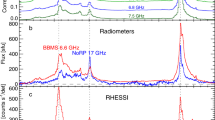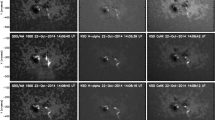Abstract
The evolution of coronal and chromospheric structures is examined together with magnetograms for the 1B flare of January 19, 1972. Soft X-ray and EUV studies are based on the OSO-7 data. The Hα filtergrams and magnetograms came from the Sacramento Peak Observatory. Theoretical force-free magnetic field configurations are compared with structures seen in the soft X-ray, EUV and Hα images. Until the flare, two prominent spots were connected by a continuous dark filament and their overlying coronal structure underwent an expansion at the sunspot separation rate of 0.1 km s−1. On January 19, the flare occurred as new magnetic fields emerged at ∼ 1019 Mx h−1 beneath the filament, which untwisted and erupted as the flare began. The pre-flare coronal emissions remained unchanged during the flare except for the temporary addition of a localized enhancement that started 5 min after flare onset. EUV lines normally emitted in the upper transition region displayed a sudden enhancement coinciding in time and location with a bright Hα point, which is believed to be near the flare ‘trigger’ or onset point. The EUV flash and the initial Hα brightening, both of which occurred near the center of the activated filament, were followed by a second EUV enhancement at the end of the filament. The complete disruption of the filament was accompanied by a third EUV enhancement and a rapid rise in the soft X-ray emission spatially coincident with the disappearing filament. From the change of magnetic field inferred from Hα filtergrams and from force-free field calculations, the energy available for the flare is estimated at approximately 1031 erg. Apparently, changes in the overlying coronal magnetic field were not required to provide the flare energy. Rather, it is suggested that the flare actually started in the twisted filament where it was compressed by emerging fields. Clearly, the flare started below the corona, and it appears that it derived its energy from the magnetic fields in or near the filament.
Similar content being viewed by others
References
Bruzek, A: 1967, Solar Phys. 2, 451.
Dunn, R. B: 1969, Sky Telesc. 38, 368.
Dunn, R B: 1971a, in R. Howard (ed), ‘Solar Magnetic Fields’, IAU Symp. 43, 65.
Dunn, R. B.: 1971b, in C. Macris (ed.), Physics of the Solar Corona, D. Reidel Publ. Co., Dordrecht-Holland, p. 114.
Frazier, E. N.: 1972, Solar Phys. 24, 98.
Hudson, H. and Okhi, K.: 1972, Solar Phys. 23, 155.
Hyder, C. L.: 1967, Solar Phys. 2, 49.
Kane, R. R. and Donnelly, R. F.: 1971, Astrophys. J. 164, 151.
Nakagawa, Y. and Raadu, M. A.: 1972, Solar Phys. 25, 127.
Neupert, W. M.: 1968, Astrophys. J. 153, L59.
Neupert, W. M., Nakagawa, Y., and Rust, D. M.: 1975, to be published.
Neupert, W. M., Thomas, R. J., and Chapman, R. D.: 1974, Solar Phys. 34, 349.
Phillips, K. J. H., Neupert, W. M., and Thomas, R. J.: 1974, Solar Phys. 36, 383.
Priest, E. R. and Heyvaerts, J.: 1974, Solar Phys. 36, 433.
Roy, J.-R.: 1972, Solar Phys. 26, 418.
Roy, J.-R. and Tang, F.: 1974, BBSO preprint.
Rust, D. M.: 1972, Solar Phys. 25, 141.
Rust, D. M.: 1973, AFCRL Environmental Res. Papers, No. 440.
Rust, D. M. and Roy, J.-R.: 1971, in R. Howard (ed.), ‘Solar Magnetic Fields’, IAU Symp. 43, 569.
Rust, D. M. and Roy, J.-R.: 1974, AFCRL Environmental Res. Papers, No. 474.
Tanaka, K. and Nakagawa, Y.: 1973, Solar Phys. 33, 187.
Veeder, G. J. and Zirin, H.: 1970, Solar Phys. 12, 391.
Weart, S. and Zirin, H.: 1971, Pub. Astron. Soc. Pacific 81, 270.
Author information
Authors and Affiliations
Additional information
NCAR is sponsored by NSF.
Rights and permissions
About this article
Cite this article
Rust, D.M., Nakagawa, Y. & Neupert, W.M. EUV emission, filament activation and magnetic fields in a slow-rise flare. Sol Phys 41, 397–414 (1975). https://doi.org/10.1007/BF00154077
Received:
Revised:
Issue Date:
DOI: https://doi.org/10.1007/BF00154077




